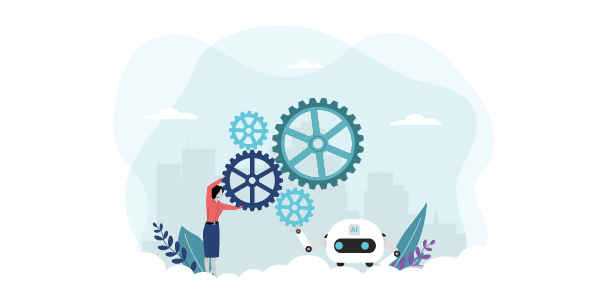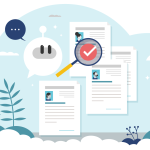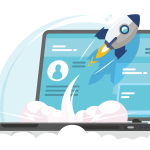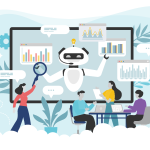Artificial Intelligence: Asset or Byte of Trouble for Your Business?
October 25, 2024

Al is leaning in to becoming your perfect new employee, one who never sleeps, always learns and can handle repetitive tasks without skipping a bit. Whether it’s streamlining customer service with chatbots or analyzing mountains of data faster than any human could, AI is no longer a concept of the future—it’s right here, right now, changing how we work. By automating mundane tasks and offering data-driven insights that were once impossible to obtain, AI offers an exciting promise of increased productivity, efficiency, and innovation.

While the perks of AI are exciting, the rise of these technologies also brings some serious risks—especially when employees start using them without clear oversight. As AI becomes more accessible, you and your team might already be experimenting with tools like ChatGPT, Scribe, or Fireflies in your everyday workflows. The problem? When you dive into these powerful technologies, you could be unintentionally exposing your company to serious vulnerabilities. With AI’s growing presence, it’s important to recognize and manage the risks it brings along:
Disclaimer: Please note that the information provided herein offers guidelines only. It is not exhaustive and does not constitute legal, insurance, or cybersecurity advice. For more guidance, please consult a lawyer, a licensed insurance representative, and/or a cybersecurity specialist.
What’s the harm in It?
As AI becomes more common, the risks of data leaks, compliance issues, or even full-scale security breaches loom large. The result? fallout from mishandled AI could cost you millions in fines, damage your reputation, or even grind your business to a halt.
And the stats back it up. According to the 2023 Microsoft Data Security Index, 43% of organizations cite a lack of visibility into AI risks as a top concern. Even more alarming? 35% of professionals are worried about not having the right tools to protect the data shared through AI systems.
Looking ahead, by 2027, regulatory pressures are expected to catch up with AI. Experts predict that at least one major global company could face a complete AI shutdown for noncompliance with data protection laws—leading to major fines, reputational harm, and even potential business collapse.
While there’s no doubt that AI is transforming the workplace, it’s also introducing new risks like:
1. Data Privacy: AI Doesn’t Know What’s “Sensitive”
Here’s the reality: when employees are using AI tools without clear direction, they could be unknowingly sharing sensitive information with external servers. This isn’t just a minor slip-up—it opens the door to serious data security risks.
Imagine an employee using ChatGPT to generate a marketing report. If they input customer data or proprietary company strategies, that information could be exposed, putting your organization in a tricky spot with privacy laws and confidentiality agreements.
2. AI Bias: When “Smart” Tools Get It Wrong
Another major concern is the potential for biased outputs. AI learns from massive amounts of data, and if this data is flawed, the results can be biased. For example, consider a company using AI to screen job applications. If the AI has been trained on data that favours a particular demographic, it might unfairly reject qualified candidates from other backgrounds. This is particularly concerning in areas like hiring, customer service, and employee evaluations. When AI makes biased recommendations, it can unfairly impact people based on things like their race, gender, or age. It’s crucial to stay mindful of this issue to make sure that everyone is treated fairly and with respect.
3. Many-of-a-Kind: AI Plagiarism and Brand Dilution
Many people use AI-generated content for marketing materials like blogs and reports without reviewing it thoroughly. This can be a problem if the information is inaccurate—there have been lawsuits related to personal injury due to incorrect AI-generated information.
Marketing plays a crucial role in identifying your unique brand voice. And, relying too heavily on AI content can make your brand sound like everything else out there. AI tends to recycle similar ideas, which dilutes brand originality and brand voice. It’s essential to put your own spin on AI-generated content, ensuring it aligns with your unique identity and message.
Treating AI like Google—accepting its output as fact—can also be risky, potentially inviting legal issues. AI systems like ChatGPT don’t function like search engines; instead, they generate content based on data patterns, not factual accuracy. This can lead to misinformation if not properly reviewed.
4. Cybercrime: AI is the New Weapon
AI can also make cybersecurity risks worse. It enhances phishing attacks, where scammers try to trick employees into revealing sensitive information. With AI’s ability to create convincing impersonations, phishing emails can be hard to spot, making it easier for employees to fall for them and put sensitive information at risk.
But it doesn’t stop there. Cybercriminals can create realistic deepfake videos or audio clips to impersonate executives. Imagine receiving a video message from someone who looks and sounds just like your boss, asking for sensitive data or a funds transfer.
On top of that, AI can speed up the process of finding weak spots in your security system, giving hackers a faster way to launch attacks. This increases the likelihood of successful cyberattacks, potentially resulting in hefty fines and long-term damage to customer trust.
5. Job Fears: Will AI Replace Me?
Finally, there’s the looming worry about employee replacement. AI can do tasks faster and often better than humans, making it tempting to cut costs by replacing workers. This raises anxiety about job security and working conditions. For instance, if your customer support team relies on AI chatbots for initial queries, employees might fear that their roles will be eliminated as AI takes over more tasks.
While AI can handle repetitive tasks, it lacks the human intuition, creativity, and adaptability that are essential in many situations. A well-trained team brings insights and emotional intelligence that AI simply can’t replicate, making them invaluable even as technology evolves.
What’s the solution?
With AI’s incredible potential, trying to banish its use might seem like the safest route—but doing so would be like tossing out the treasure with the trash. You can’t ignore the massive benefits it brings, but you also can’t let it run wild.
But, there’s a simpler, smarter maneuver: control the chaos. By setting clear guidelines and embracing AI responsibly, you can harness its power without putting your business at huge risk. Here’s how you can find that balance:
1. Conduct an AI Audit
Start by identifying which AI tools your employees are using—there may be some you didn’t even know about! This audit will help you understand how AI is being used in your organization and spot potential risks.
Also, review the privacy policies and data practices of these tools. Before allowing employees to use them, make sure you understand how they handle sensitive data. This will ensure you’re protecting your business from unnecessary vulnerabilities.
2. Implement Clear Policies
Set clear guidelines for using AI tools in your workplace. Make sure employees understand what is allowed and what isn’t. Having well-defined guidelines helps prevent accidental data breaches and encourages accountability. For instance, you might create a policy that forbids entering confidential information into AI tools and outlines consequences for not following it.
3. Monitor AI Outputs
To keep bias in check when using AI, it’s essential to regularly review what these systems are producing. Why is this important? Well, unchecked biases can lead to unfair outcomes that could harm your business and your reputation. One way to tackle this is by limiting AI use in high-stakes situations where decisions really need to be clear and justifiable.
Encourage your team to think critically about the AI-generated decisions they encounter and to explain their thought processes. This can really help keep things on the right track. Plus, forming an AI oversight committee can provide a dedicated group that regularly evaluates your AI systems and their impact, ensuring that your organization maintains strong ethical standards.
4. Provide Training
Investing in employee training is crucial. Offer ongoing training about the risks associated with AI and best practices for handling sensitive information. This will help your team use AI tools safely and effectively. Consider hosting workshops or seminars that include real-world examples of how AI can be used responsibly.
RELATED: Security Awareness Training: What is it, Best Practices, & More.
5. Review and Update Contracts
Make sure to review and update your contracts and policies. Ensure that they address AI-related issues, including data privacy, employee rights, and any contractual obligations that may arise from using AI technologies. Clear communication about how AI will be used in the workplace can help manage employee expectations and reduce anxiety around job security.
In non-union workplaces, there are legal implications to consider when using AI to replace employees. You’ll want to ensure that laid-off employees receive their proper entitlements while avoiding unfair or discriminatory practices. It’s also crucial to handle any significant changes to job duties carefully, as this can lead to claims of constructive dismissal.
In unionized settings, employers usually have the right to change job duties, but you need to communicate with unions and provide notice before implementing AI that could affect job security. This transparency helps foster trust and collaboration between management and employees, helping everyone feel more secure as you navigate the changes that AI brings.
6. Enhance Cybersecurity Measures
Strengthening your organization’s cybersecurity measures is also key. Start by providing regular training for employees on how to identify cyber threats. This will empower them to stay alert and respond effectively. For instance, running simulations of phishing attacks can help employees practice spotting fraudulent emails before they encounter real ones.
In addition to training, implement strict verification processes for digital communications. Require employees to confirm sensitive requests through multiple channels, such as a follow-up call or a secure messaging app. This extra layer of verification can significantly reduce the risk of falling for scams.
On the IT side, ensure you have robust security measures in place. Utilize advanced firewalls and encryption to protect sensitive data. Regularly update software and security protocols to guard against new vulnerabilities. Investing in comprehensive security solutions, like intrusion detection systems and anti-malware tools, can further enhance your defence against cyber threats. By combining employee training with strong IT measures, you can create a proactive approach to cybersecurity that helps safeguard your organization against potential breaches.
RELATED: Unchecked AI: Top Cyber Risks for Businesses.
7. Get Cyber Insurance
As technology evolves at lightning speed, it’s nearly impossible to be completely prepared for all the risks associated with AI use. That’s where Cyber Insurance becomes an essential safety net if things go south. Simply put, having the right coverage can offer peace of mind amid potential risks. Cyber Insurance can help cover losses from data breaches, compliance violations, and other incidents related to AI use. Many policies also offer funds for legal breach coaching and PR assistance to help mitigate damage and manage crises effectively.
Plus, working with a licensed broker like PROLINK is crucial in navigating the unique risks that come with your business’s AI technologies. Our experts can help personalize your policy to address unique risks associated with AI technologies, ensuring you’re prepared for any challenges that come your way, even as the landscape of technology continues to change.
RELATED: All About Cyber Insurance: What is it, What’s Covered, & Why You Need it.
AI is transforming the workplace, bringing both exciting advancements and new challenges. As an employer, staying proactive is essential to creating a secure and efficient work environment. By understanding the risks, putting strong policies in place, and investing in ongoing training, you can ensure your team is prepared for what’s ahead. So, while you embrace this tech revolution, a byte of caution goes a long way.
PROLINK’s blog posts are general in nature. They do not take into account your personal objectives or financial situation and are not a substitute for professional advice. The specific terms of your policy will always apply. We bear no responsibility for the accuracy, legality, or timeliness of any external content.




